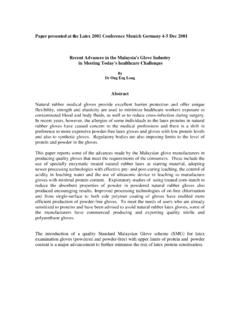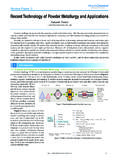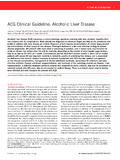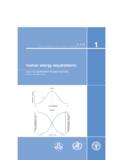Transcription of Advances in Load Bank Testing - Avtron Froment
1 Advances in load Banks for Generating Set Testing - 1 - JWB 30/11/2004 Advances in load Banks for Generating Set Testing Introduction All engine-driven generating sets will, at some time, require load Testing . This may be at the initial design stages, for example type Testing ; as part of the manufacturing process, such as final test; during commissioning or as part of a maintenance plan. Typically the test methods and criteria will be based on ISO 8528 (BS 7698) part 6. The standard defines three performance classes and associated criteria - G1, G2 and G3 (a further class, G4, is reserved for performance criteria that are agreed between the supplier and the buyer). load Banks have been used for the load Testing of generating sets and Uninterruptible Power Supplies (UPS) for many years.
2 Often, the load bank is the only solution that provides a controllable test load , whether it is a single resistive load bank or a combination of resistive and inductive load to provide non-unity power factor Testing . So what can you expect from a modern load bank system? load Control All load banks need to provide a method to select and apply load to the generator set or supply on test. One of the simplest forms of load control is an array of toggle switches, mounted on the load bank . It is mainly limited to small resistive load banks. An array of, say 5kW, 10kW, 20kW, 20kW and 50kW switches would allow loads of up to 105kW to be selected within 5kW. The requirement to apply step load changes when performing generator transient response tests has meant that the rotary decade switch has replaced the toggle switch.
3 Typically, three decade switches allow any load from 0 to 999kW to be pre-selected in 1kW steps. An Accept push button then applies the pre-selected load ; a Reject button would remove any load . This type of load control is frequently provided in a remote unit so it can be used next to the generator when setting up the voltage regulator (AVR) and governor stability. Today, most test and commissioning engineers will often be working with different supply voltages and frequencies. One day they may need to apply 500kW at 400V 50Hz and the next they may want the same load bank to apply 500kW onto a 480V 60Hz generating set. This requires the load control system to be able to correct for different supply voltages. One technique is to provide a voltage selection switch; but modern load bank control systems can automatically adjust to differing supply voltage and frequency making the load bank operation easier and ensuring the generator is loaded correctly, without the need for the engineer to do manual calculations.
4 By combining both instrumentation and load control, today s microprocessor-based load control system can simplify load Testing by providing: Automatic detection of the supply on test (voltage, frequency and phases) and phase rotation to verify the supply connection before Testing . Advances in load Banks for Generating Set Testing - 2 - JWB 30/11/2004 Manual load control in Percent load or kW, kVA and Power Factor removing the need to calculate kW and kVAr. load correction using both closed loop load control along with stored load history to compensate for voltage changes and ensure the correct load step is applied. Automatic load control for repetitive or cyclic Testing . Instrumentation The test engineer is particularly interested in the engine governing, which is measured by Testing frequency; and the alternator voltage regulation, which is measured directly.
5 In addition, it is important to verify the loading conditions applying more load than necessary makes the test more stringent, whilst too little load may make the test invalid. To meet these requirements the load bank instrumentation should be able to measure the three-phase generator voltages (V) and currents (A) along with the frequency (Hz). In addition, it must be able to measure power, both real or active power (kW) and apparent power (kVA) as well as the power factor. When Testing against ISO 8528 the specified criteria relating to frequency include steady-state variation, dip when maximum power increase is applied, rise when 100% power is removed and the time before the frequency returns within limits in both cases. Voltage characteristics again include steady-state variation, the permissible dip when maximum power increase is applied, the rise when 100% load is removed and the recovery time.
6 The instrumentation system should be able to display these parameters in real-time along with a graphical representation of the voltage and frequency behaviour after each load application or rejection. Finally, most customers require a load test report. The load control system must be capable of logging the data and producing a test report. Sigma Control System The Sigma load control system is an advanced microprocessor-based control and instrumentation system specifically developed for load bank applications. Every Sigma controlled load bank has its own embedded controller complete with six high accuracy voltage and current transformers, all located within the load bank . The instrumentation is processed digitally with high-speed sampling of the raw data, providing full three-phase true rms measurements with high update rates.
7 Control and instrumentation data is available over the load bank control network allowing any combination of up to 14 load banks to be controlled as one single load system. The load bank system can be controlled from either a rugged Intelligent Hand-Held Control (IHT) or a standard Windows-based PC running the Sigma PC Software. Intelligent Hand-Held Control (IHT) The Sigma Intelligent Hand Held Terminal (IHT) provides full load control and three-phase instrumentation on any Sigma controlled load bank . Advances in load Banks for Generating Set Testing - 3 - JWB 30/11/2004 As standard it has built in Help with full multi-language support including English, French, German, Spanish and Italian. In addition it has a fully integrated printout facility to record data.
8 To provide integration with building automation systems (BMS) or automated test systems the IHT has an interface which complies with the Modbus Protocol and provides full remote control and instrumentation of the load bank system. PC Software The Sigma PC System provides enhanced load control along with transient speed instrumentation, real-time graphs, full data acquisition and reporting. The quick start wizard gets you up and running quickly either by setting up the system for a manual test or by leading you through the stages to write a full transient test program. A simulation mode lets you try out your program before connecting the generator. When you have finished Testing you can print data in the inbuilt report formats or export the data to applications such as Microsoft Excel for further analysis.
9 Conclusion load bank control and instrumentation systems have developed significantly over recent years. With the introduction of advanced load control systems the instrumentation has become an integral part of the system providing close loop control. Standard benefits now include multiple load bank control, load correction, transient speed instrumentation, real-time graphs, full data acquisition and reporting. As engine-driven generators continue to develop, and full compliance with new emissions and noise legislation becomes necessary, the use of a modern load control and instrumentation system has become more important. The test engineer can now concentrate on the generating set and not the test equipment, even when carrying out complex non-unity power factor tests.
10 load bank specialists such as Froment can provide the equipment, with control, instrumentation, data capture and analysis systems to meet the test requirements of the International Standards. John Barratt N J Froment and Co Ltd Easton-on-the-Hill STAMFORD PE9 3NP United Kingdom +44 (0) 1780 480033








